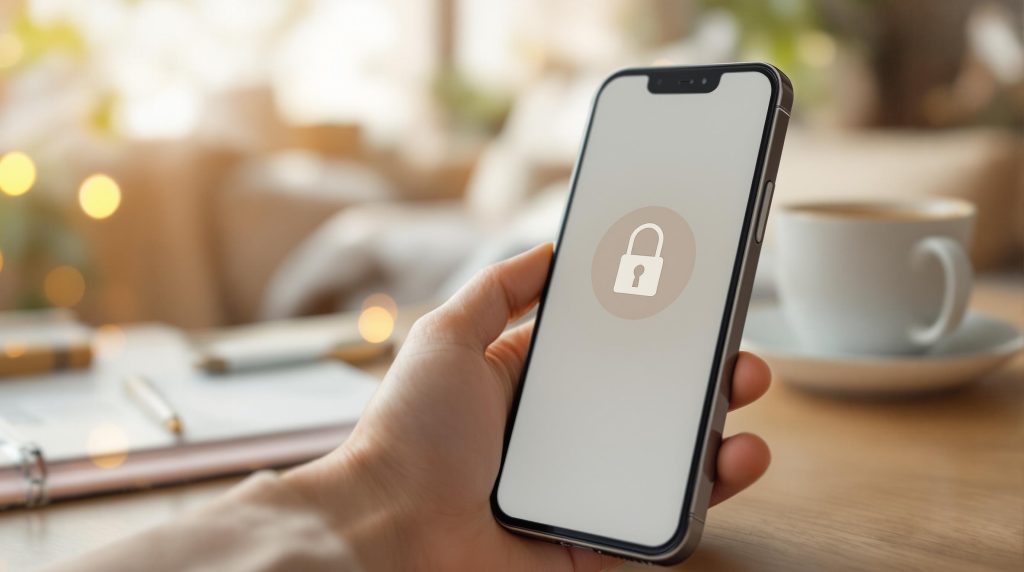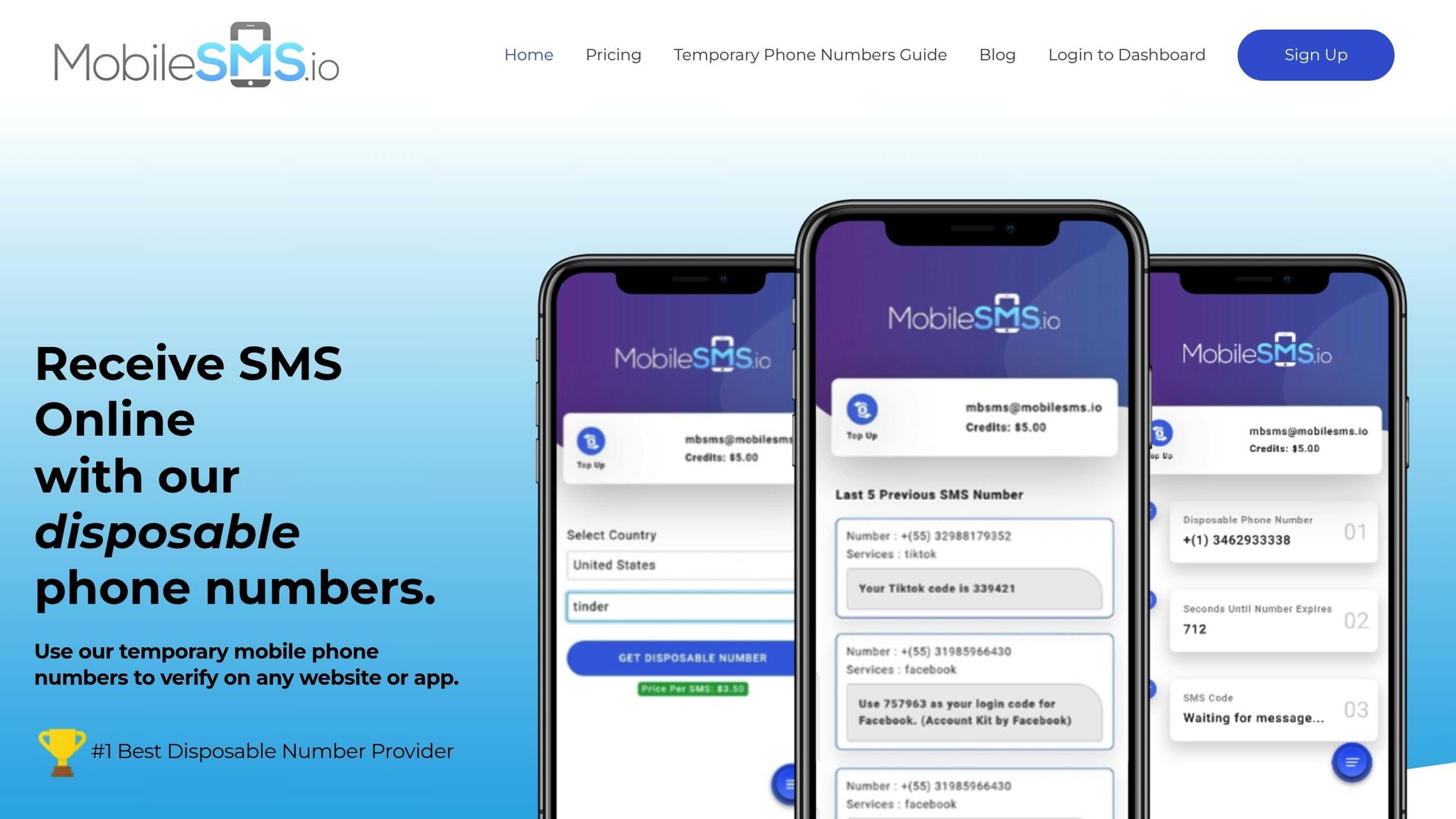- Choose a Secure Messaging App
Look for features like end-to-end encryption, metadata protection, and open-source transparency. Apps with decentralized or distributed designs offer better privacy. - Use a Clean Device
Set up a dedicated device for anonymous use. Perform a factory reset, avoid personal accounts, and configure a VPN to hide your IP address. - Create an Anonymous Profile
Use a private username, strong passwords, and a temporary phone number from services like MobileSMS.io for account verification. - Register Securely
Use disposable email addresses and phone numbers for verification. Enable two-factor authentication (2FA) and adjust privacy settings to limit exposure. - Keep Messages Private
Update apps regularly, enable message expiration, turn off cloud backups, and restrict message forwarding to maintain security.
BEST Encrypted Messaging Apps Compared: Chat Privately!
Step 1: Pick a Secure Messaging App
To protect your privacy, start by selecting a secure messaging app. Pay close attention to its security features, system design, and level of transparency.
Check Security Features
When evaluating messaging apps, look for these key security features:
- End-to-end encryption: Ensures only you and the recipient can read the messages.
- Zero-knowledge architecture: Prevents the service provider from accessing your messages.
- Metadata protection: Minimizes the collection of data about your activity and connections.
- Local data storage: Keeps messages stored on your device instead of the cloud.
- Forward secrecy: Uses a unique encryption key for each message, adding an extra layer of protection.
Compare System Design
The architecture of a messaging app plays a big role in privacy. Decentralized platforms, in particular, offer several advantages:
- No single point of failure: Messages are routed through multiple nodes, making the system more secure.
- Reduced data collection: Without a central server, your data isn’t stored in one place.
- Peer-to-peer connections: Allows direct communication between users.
- Network resilience: The system can continue functioning even if some nodes fail.
- Distributed trust: No central entity controls the network.
| Architecture Type | Privacy Benefits | Security Advantages |
|---|---|---|
| Decentralized | No central data collection | Multiple encryption layers |
| Distributed | No single point of failure | Peer verification |
| Federated | Freedom to choose servers | Cross-platform encryption |
Review Open-Source Transparency
Open-source apps provide an extra level of trust because their code is publicly accessible. This allows for:
- Community audits: Anyone can review the code to ensure it’s secure.
- Bug reporting: Vulnerabilities can be identified and fixed quickly.
- Encryption validation: Confirms the app uses proper encryption methods.
- Feature verification: Ensures privacy features are functioning as promised.
Choose apps that maintain public code repositories and undergo regular security audits. This openness ensures that the app delivers on its privacy promises.
Step 2: Set Up a Clean Device
Using a separate device for anonymous messaging helps keep your personal life and private communications completely separate.
Use a Dedicated Device
A dedicated device ensures no overlap with personal data, reducing the risk of exposing your identity. Here’s how to start:
- Perform a factory reset to wipe the device clean.
- Operate the device without connecting it to personal accounts or data.
This creates a secure base for the privacy measures you’ll add next.
Configure VPN Protection
Once your device is ready, safeguard your internet activity with a VPN:
- Set up auto-connect so the VPN activates whenever the device accesses the internet.
- Pick a VPN provider that doesn’t store logs.
- Enable a kill switch to prevent data leaks if the VPN disconnects.
- Test your connection to confirm your real IP address is hidden.
It’s best to configure your VPN before installing messaging apps or creating accounts, ensuring all traffic is encrypted from the beginning.
Remove Personal Data
To ensure the device stays anonymous, remove any personal data:
- System cleanup: Delete any apps that might collect data and reset system settings to default.
- Account separation: Avoid logging into personal email, cloud storage, app stores, or browser sync services.
- Privacy settings:
- Turn off location services.
- Disable automatic backups.
- Remove keyboard learning data.
- Turn off analytics and diagnostics.
For account verification, consider using a disposable number from services like MobileSMS.io. This step ensures your device is ready for secure, anonymous communication.
| Privacy Feature | Action Required | Verification Method |
|---|---|---|
| Device Reset | Factory reset | Check settings menu |
| VPN Setup | Enable auto-connect | Test IP address |
| Personal Data | Remove all traces | Review system storage |
| Account Verification | Use a disposable number | MobileSMS.io |
sbb-itb-5a89343
Step 3: Create an Anonymous Profile
Once your device is secure, the next step is to build a digital identity that keeps your privacy intact. This process requires careful attention to detail.
Choose a Private Username
Your username should not give away any personal details. Here’s how to keep it anonymous:
- Avoid using parts of your real name, birth year, or location.
- Stay away from references to hobbies or interests that could identify you.
- Don’t reuse usernames from other accounts.
- Opt for random combinations of letters and numbers.
- Use an automated username generator for added randomness.
A good anonymous username might look like "Kj7_mP9x2" instead of something like "JohnNYC1990", which reveals your name, location, and birth year. After choosing a username, secure your account with a strong password.
Create Strong Passwords
Passwords should be tough to guess and unique for every account. Follow these guidelines:
- Use at least 16 characters.
- Include a mix of uppercase and lowercase letters, numbers, and symbols.
- Avoid using personal information.
- Generate passwords with a password manager for added security.
| Password Component | Good Example | Avoid |
|---|---|---|
| Length | 20+ characters | Under 12 |
| Complexity | K9$mP2#vL5nX8@jR | password123 |
| Uniqueness | Different per app | Same everywhere |
| Personal Info | None included | Birthday/pet names |
Keep Your Profile Anonymous
Make sure your profile settings and details don’t compromise your privacy:
- Profile Picture: Use abstract art or AI-generated images instead of personal photos.
- Bio Section: Leave it blank or use generic text that reveals nothing about you.
- Contact Info: Use temporary numbers, like those from MobileSMS.io, for account verification.
- Location: Turn off location sharing in all settings.
- Status Messages: Avoid sharing personal updates or activities.
- Connected Accounts: Don’t link your profile to other social media or messaging platforms.
Step 4: Register Securely
Make sure your registration process is secure to safeguard your identity.
Use a Temporary Email
- Use a temporary email service dedicated to this purpose.
- Create a unique email address for each registration.
- Delete the temporary email once the setup is complete.
- Never reuse email addresses.
- Avoid using patterns in your email that could identify you.
After setting up your email, move on to phone verification using MobileSMS.io.
Verify with MobileSMS.io
For anonymous phone verification, MobileSMS.io is a reliable option:
| Verification Type | Duration | Best Use Case |
|---|---|---|
| One-time Number | 10 minutes | Single app registration |
| Short-term Rental | 7-14 days | Multiple verifications |
| Long-term Rental | 30-90 days | Regular re-verification |
Steps to Verify:
- Purchase verification credits.
- Choose a temporary number.
- Enter the number in the app or service you’re verifying.
- Retrieve the verification code from your MobileSMS.io dashboard.
- Use the code to complete verification.
Configure Security Features
Once your account is verified, enhance its security by enabling these features:
Two-Factor Authentication (2FA)
- Use an authenticator app for 2FA instead of SMS.
- Securely store your backup codes for emergencies.
Session Management
- Set automatic logout timers for inactive sessions.
- Enable notifications for login activity.
- Regularly review and terminate any unfamiliar sessions.
Privacy Settings
- Turn off read receipts and typing indicators.
- Set messages to auto-delete after a specified time.
- Adjust profile visibility with strict privacy controls to limit exposure.
Step 5: Keep Messages Private
Once you’ve set up your anonymous account, it’s crucial to stay vigilant about keeping your messages private. Here’s how you can maintain strong privacy and security:
Install Security Updates
Make sure to enable automatic updates for your messaging apps. Regularly review app permissions to ensure they align with your privacy preferences.
Use Message Expiration Features
Set messages to automatically delete after a specific time. This reduces your digital footprint and keeps sensitive conversations from lingering. For chats without this feature, make it a habit to delete them manually.
Review and Adjust Privacy Settings
Take control of your privacy by fine-tuning your settings. Here are key areas to focus on:
- Location Sharing, Read Receipts, and Online Status: Decide who can see your activity and location.
- Profile Information: Limit who can view your profile photo and other details.
- Group and Message Controls: Adjust settings to control who can add you to groups, forward your messages, or access your status updates.
Strengthen Data Access Controls
Protect your data with these extra measures:
- Disable Cloud Backups: Avoid storing messages in the cloud, where they might be vulnerable.
- Turn Off Automatic Media Downloads: Prevent unwanted files from being saved automatically.
- Enable Screenshot Blocking: If available, this feature stops others from capturing your chats.
- Restrict Message Forwarding: Limit how easily your messages can be shared.
Wrapping Up
To maintain anonymity in messaging, stick to these steps carefully. This guide covers all the key actions to protect your identity while keeping communication efficient.
Using disposable phone numbers is a key step for creating anonymous accounts. These temporary numbers, active for about 10 minutes, let you complete verifications without tying them to your personal information.
- Choose a secure messaging app with strong encryption and privacy features
- Prepare a clean device and use a reliable VPN
- Build your anonymous profile following proven privacy techniques
- Verify accounts with disposable, SIM-based numbers from MobileSMS.io
- Adjust your message privacy settings for extra security
For ongoing privacy, consider long-term rental numbers when needed. This is especially useful for digital nomads or anyone managing multiple verifications across platforms.
Make it a habit to update your security settings and review your privacy practices. Following these steps ensures your messaging stays private while remaining functional. From selecting the right app to verifying with MobileSMS.io, you’ll have a reliable system to safeguard your digital communications.


